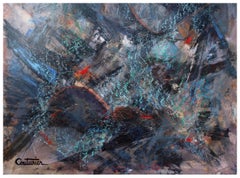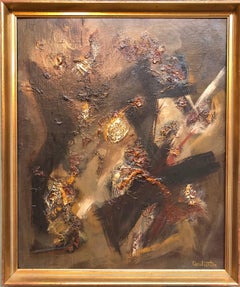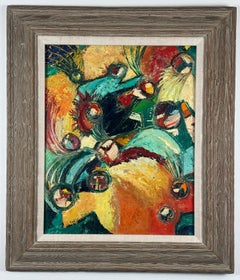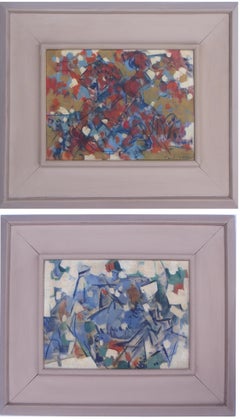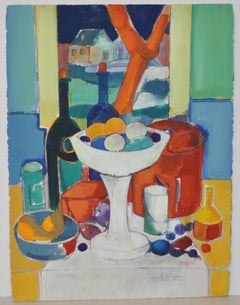Rene Couturier Paintings
Rene Couturier is known for abstract still life, figure and landscape painting. This expressive French colorist was born in Dieppe, Normandy, in 1933 and attended the École des Beaux-Arts of Marseilles. From 1958–68, he was represented in several groups and salon shows in France. Since completing his studies, Rene has lived in Mexico, the United States, Africa and France and has exhibited internationally with success.
to
1
1
Overall Width
to
Overall Height
to
2
1
1
2
1
1
2
2
1
1
1
3
781
720
712
697
2
Artist: Rene Couturier
Space Abstract, Mid Century Abstract Expressionism with Grey, Black, Blue, Red
By Rene Couturier
Located in Soquel, CA
Dynamic midcentury modern abstract expressionist painting by Normandy artist Rene Couturier (French, b. 1933), circa mid-1960s. A grey and black plane comprised of clashing diagonals...
Category
1960s Abstract Expressionist Rene Couturier Paintings
Materials
Masonite, Oil
French Gestural Abstract Expressionist Textured Oil Painting
By Rene Couturier
Located in Surfside, FL
Rene Couturier lives in the Netherlands and France. Rene Couturier is known for abstract still life, figure and landscape painting.
Rene' Couturier is an artist whose works displays...
Category
1970s Abstract Expressionist Rene Couturier Paintings
Materials
Canvas, Oil
Related Items
Untitled (Abstract Expressionist Painting)
By Bertha Davis
Located in Wilton Manors, FL
Bertha G. Davis (1911-1997)
Untitled, ca. 1960's
Oil on cradled masonite panel.
16 x 20 inches; 24 x 28 inches framed.
Signed lower left. Artist estate stamp on verso.
Vintage custom wormy chestnut frame.
A painter of cityscapes, landscapes, and abstracts in Texas, Bertha G Davis was primarily a self-taught artist whose style was influenced by her early life experiences in pre-World War II Lithuania and later Mexico. Her style is expressionistic*, relying on color to denote her profound feelings. She works primarily in watercolor and acrylic with some mixed media*.
She is the daughter of Abraham and Dvora Germaize of Vilna, Lithuania and grew up in Jewish ghettos in Vilna, Alita, and Kovno. Davis was influenced by her father who was a decorative wood-worker and carpenter in Lithuania. The family of five daughters and a son escaped to Mexico City in the late 1920’s because of Jewish oppression. The images and emotions she experienced had no outlet.
She was known as a beauty, and at age 17 was named Jewish Miss Mexico, barely able to speak Spanish having just emigrated from Eastern Europe. Irving Davis, a merchant from Texas who had also come from Eastern Europe via Cuba, saw her at this event where she was crowned Jewish Miss Mexico, and three days later asked for her hand in marriage. They moved to a small town in Texas, raising a family.
Her daughter, Sylvia, was born when Davis was 20 and they were inseparable. As Sylvia became an actress, painter, and sculptor, Davis was amazed at the capacity for creativity. Davis didn’t begin her own artistic journey until she was 47, when her daughter Sylvia Caplan encouraged her to try. She was inspired by this daughter who gave her a drugstore palette of watercolors, paper and brushes and told her to “just try.” Davis did not put down her palette and brushes until her death in 1997.
Bertha G Davis was primarily self-taught but maintained a style oriented toward color and texture that reflected her strong feelings. Most of her early work was done while she lived in McAllen, Texas where she was known for her contribution to art and showed her work and the work of other artists at the Bertha Davis Gallery.
She studied with Stewart Van Orden, at Pan American College in 1960-61; and was a student at the Art Institute San Miguel Allende, Mexico, 1965. She was also a student of Harold Phenix...
Category
Mid-20th Century Abstract Expressionist Rene Couturier Paintings
Materials
Masonite, Oil
$975 Sale Price
35% Off
H 28 in W 24 in D 1 in
Abstracted pair of oil paintings by Carl Holty
By Carl Holty
Located in Hudson, NY
These artworks by Carl Holty are only sold as a pair. Each painting measures 9" x 11" and framed 18" x 20.25" x 2.5"
The red and gold work is signed "Carl Holty" in the lower right.
About this artists: Carl Holty was awakened to his interest in art as a child through visits to the Layton Art Gallery of Milwaukee, and began painting lessons with Friedrich Wilhelm Heine at a young age. Though born in Freiburg, Germany, in 1900, he was raised in Wisconsin and enrolled at Marquette University. Before long, Holty abandoned his pre-medical studies in order to pursue art. He spent a summer at the School of the Chicago Art Institute in Saugatuck, Michigan, and set off for New York in 1920. He then studied at the National Academy of Design under Francis Coates Jones...
Category
1940s Abstract Expressionist Rene Couturier Paintings
Materials
Canvas, Oil
Byzantium, original signed painting by renowned Abstract Expressionist, Framed
By Ben Wilson
Located in New York, NY
Ben Wilson
Byzantium, 1975
Oil on Masonite painting
Hand signed reverse, Titled, "Byzantium", dated 1975 by the artist and also with estate stamp - in addition to Ben Wilson's hand s...
Category
1970s Abstract Expressionist Rene Couturier Paintings
Materials
Masonite, Oil
$12,000
H 19.5 in W 16.5 in D 1.5 in
Untitled
By John Opper
Located in Austin, TX
Waterline Fine Art, Austin, TX is pleased to present the following work:
Oil on canvas. Signed lower right, signed and dated verso.
62.25 x 56.25 in.
64 x 58 in. (framed)
Custom framed in a natural cherry wood floater.
Provenance
Washburn Gallery, New York
Behnke Doherty Gallery, Washington Depot, CT
Born in 1908 in Chicago, John Opper moved with his family to Cleveland, Ohio, in 1916. In high school, he began studying art and attending classes at the Cleveland Museum of Art.
After graduation, he enrolled in the Cleveland School of Art (now Cleveland Institute of Art), only to withdraw after a year and move to Chicago, where he took classes at the Art Institute of Chicago. He eventually returned to Cleveland, enrolling at Western Reserve University (now Case Western Reserve), receiving his bachelor’s degree in 1931. The Depression has taken hold during this period, so Opper found work by teaching metalworking and sketching classes at the Karamu Settlement House, the oldest African American theater in the United States.
In 1933, Opper traveled to Gloucester, Massachusetts, eventually connecting with the artist Hans Hofmann, who was teaching at the school run by Ernest Thurn. Hofmann encouraged Opper to work “in a more modern vein and start finding what it’s all about.” Heeding this advice, Opper relocated to New York, co-founding a mail-order club of American and British prints for dissemination to schools and museums.
By the mid-1930s, he joined the Works Progress Administration (WPA) Easel Division, and also began attending the 57th Street school that Hans Hofmann had established after leaving the Art Students League. Looking back at his time at the school, Opper felt that beyond Hofmann’s teaching, most advantageous was his contact with fellow artists, including Byron Browne, Rosalind Bengelsdorf, and George McNeil. At the time, he also met Giorgio Cavallon and the sculptor Wilfrid Zogbaum.
In 1936, Opper became a founding member of the American Abstract Artists, along with Balcomb and Gertrude Greene. The organization was formed to provide an opportunity for artists to show abstract works at a time when such opportunities were scarce. This led to his first solo show in 1937 at the Artists’ Gallery in New York.
During his summer in Gloucester in 1933, Opper came to know Milton Avery. Painting in Avery’s informal studio in New York City the following winter, he became acquainted with Adolph Gottlieb and Mark Rothko. Opper participated in a couple of shows during the 1930s of the American Artists Congress Against War and Fascism, whose president was Stuart Davis. About the same period, Opper joined the Artists’ Union and served as the business manager of its publication, Art Front.
During World War II, Opper worked for a ship design company creating drawings for piping systems used in PT boats...
Category
1950s Abstract Expressionist Rene Couturier Paintings
Materials
Canvas, Oil
Ozymandias (unique, signed Abstract Expressionist painting by renowned painter)
By Ben Wilson
Located in New York, NY
Ben Wilson
Ozymandias, 1989
Oil on masonite board
Boldly signed by Ben Wilson on the back
36 × 48 inches
Unframed
Provenance: acquired from the Estate of Ben Wilson
This work is titled "Ozymandias" after the famous sonnet written by Percy Bysshe Shelley (1792-1822). Shelley's poem is one of the most poignant meditations on the fleeting nature of human power and the inevitability of decline. The poem serves as a reminder that time erodes even the most imposing empires and leaders and that the pursuit of lasting fame and control is ultimately futile.
Depending on how one views Ben Wilson's Abstract Expressionist painting of "Ozymandias" -- some of the imagery might reveal the head of an angry king and a sickle.
Shelley's poem Ozymandias reads:
I met a traveler from an antique land...
Category
1980s Abstract Expressionist Rene Couturier Paintings
Materials
Masonite, Oil
$7,500 Sale Price
50% Off
H 36 in W 48 in D 0.3 in
"Crossed Arms" Mid Century Abstract Expressionist NYC Female Artist
By Sylvia Rutkoff
Located in Arp, TX
Sylvia Rutkoff (1919-2011)
Sr5-1
c.1960s
“Crossed Arms”
Acrylic on Masonite
36x42 period frame
Unsigned
Collection acquired from family estate
Category
Mid-20th Century Abstract Expressionist Rene Couturier Paintings
Materials
Masonite, Oil
$4,000
H 36 in W 42 in D 2 in
Untitled Abstract Oil by Naohiko Inukai
Located in Hudson, NY
A richly colored abstraction by Japanese artist Naohiko Inukai. This early work demonstrates the artist's fluidity and expression with paint prior to wh...
Category
1960s Abstract Expressionist Rene Couturier Paintings
Materials
Canvas, Oil
Bold German American Abstract Expressionist Color Field Oil Painting Carl Holty
By Carl Holty
Located in Surfside, FL
Carl Robert Holty (American 1900-1973)
Abstract Expressionism Oil on Masonite board.
Abstract with greens blues and red,
Dimensions 12 x 9-1/2 inches. Framed 17 X 14 inches
Hand...
Category
20th Century Abstract Expressionist Rene Couturier Paintings
Materials
Masonite, Oil
Untitled
Located in Austin, TX
Waterline Fine Art, Austin, TX is pleased to present the following work:
Oil on canvas. Signed verso. Some scratched out, illegible writing in paint and graphite verso, which may ha...
Category
1960s Abstract Expressionist Rene Couturier Paintings
Materials
Canvas, Oil
Rock Candy Mountain (unique, signed Abstract Expressionist painting) framed 70s
By Ben Wilson
Located in New York, NY
Ben Wilson
Rock Candy Mountain, ca. 1970
Oil on masonite board (Hand Signed, titled and dated)
Hand signed, titled and dated by Ben Wilson on the back
Frame Included: held in artist'...
Category
1970s Abstract Expressionist Rene Couturier Paintings
Materials
Masonite, Oil, Permanent Marker
$7,000
H 25 in W 49 in D 1 in
Edge
Located in Austin, TX
Waterline Fine Art, Austin, TX is pleased to present the following work:
Oil on board. Signed and dated lower right and verso, titled verso.
36.25 x 48 in.
40.5 x 52.25 in. (framed)
Framed in contemporary silver, tiered floater frame.
Dennis Eugene Norman Burton was a Canadian modernist who was born in Lethbridge, Ontario. He attended the Ontario College of Art from 1952 to 1956, and worked for the Canadian Broadcasting Corporation (CBC) as a graphic designer until 1960.
Inspired by a 1955 exhibition of the “Painters Eleven” at Toronto’s Hart House, as well as American Abstract Expressionist artists such as Robert Motherwell, Jack Tworkov, and Willem de Kooning, Burton shifted his focus toward abstraction in the mid-1950s.
Burton showed with the famed Isaacs Gallery in Toronto, becoming one of the youngest members on the gallery’s roster. A talented musician, he also played saxophone in the Artist’s Jazz Band in Toronto - a pioneering Canadian free-jazz group...
Category
1950s Abstract Expressionist Rene Couturier Paintings
Materials
Masonite, Oil, Board
Etude III (abstract expressionist painting)
By Fredric Karoly
Located in Wilton Manors, FL
Fredric Karoly (1898-1987). Etude III, 1950. Oil on masonite panel measures 18 x 24 inches. Unframed. Signed, titled, dated on reverse. Good condition with minor paint loss at edges.
Biography:
An abstract painter, Karoly was born in Hungary and studied painting in Paris, architectural eingineering in Berlin, and emigrated to the U.S. in 1926. He began a successful career as a fashion and fabric designer. In 1948 he was working as a fashion director for Simplicity Patters, when he had a solo exhibition of of his oil paintings, wire montages, dry-pen drawings and abstract photography.
Solo Exhibitions:
Hugo Gallery (Alexandre Iolas) New York 1948; Gallery Mai. Paris 1949; New Gallery (Eugene Thaw) New York 1950; Museu de Arte, Sao Paulo, Brazil 1951; Miami Museum of Modern Art, Miami, Florida 1959; Loft Gallery, New York City, 1966.Group Exhibitions:
Hugo Gallery, New York 1947; Salon des Realities Nouvelles, Paris 1949-1953; Whitney Museum of American Art, New York (Annual) 1951-1953, 1963; Biennale of Sao Paulo, Brazil, 1951; International Independent Exhibition, Tokyo, 1951; Martha Jackson Gallery, New York, 1959; The Butler Institute of Art, Youngstown, Ohio, 1960; Stuttman Gallery, New York, 1960; The Art Institute of Chicago (Annual), 1960; International Watercolor Exhibition, Brookyln Museum, 1961; Westchester Art Museum, White Plains, NY, 1963; Whitney Museum, Annual, NY 1963; Cleveland Art Festival, Park Synagogue, Cleveland, 1963; Whitney Museum, Sculpture Annual, NY, 1964.Works in Institutional Collections:
Museu de Arte, San Paulo, Brazil; Museu de Bellas Artes, Buenos Aires, Argentina; New York University, New York; Washington University, St. Louis, Missouri; Finch College, NY; Barnard College, NY; Metropolitan Museum, Whitney Museum and Guggenheim Museum, New York; Museum of Fine Arts, St. Petersburg, FL.
Awards: National Council Arts Awards, 1968.
Frederic Karoly died on December 15, 1987 at the Inter-Continental Hotel in Manhattan, where he had made his home for many years.
Fredric Karoly was born in Budapest in 1893. According to Karoly’s own vitae, his exhibition history began in New York in 1947, when at the age of 54 he took part in a four-person group show at Hugo Gallery. His involvement with visual art however was apparently life long. In a brief introduction to his solo show at Galerie Mai in Paris in June of 1949, Jen Luc de Rudder, reports that Karoly began painting at the age of 12 in Budapest.
After several years of studying, then working in London, Paris and Berlin, Karoly emigrated to the United States in 1925 or 1926 (he probably first came to the US on a work visa in 1925). In New York, Karoly worked in women’s fashion as a designer.
In 1948 Karoly worked in a manner than was clearly influenced by the work of such European surrealists as Max Ernst, creating spiked automatic bi-chromatic paintings. His style progressed into a progressively more biomorphic vein, similar to explorations by Theodore Stamos, Daphnis, Milton Avery and Mark Rothko around the same period. He was supported with patronage during this period by Mrs. Mimi Baliff, who apparently supported the “Industrial Design Workshop” that she helped open to feature Karoly’s designs in 1948.
By the early 1950’s (1951) Karoly started experimenting with the drip and splatter process as well. Drip paintings dominated his process until the late 50’s-early 60’s, when linear compositional elements began to reemerge. By the late 50’s multi-layered drip grid motifs asserted a masque of spatial organization over looser washed fields and splatters of paint that Karoly worked off of. This development was consistent with concurrent explorations into the grid by artist Agnes Martin and others.
By the mid-50’s Karoly’s style began another transition into a more surface concerned “Color Field” style of painting. There are elements still reminding one of Abstract Expressionist concerns as such painters as Clifford Still. But the works that began to emerge from Karoly’s studio in 1958 presaged the Morris Lewis fan motifs and Friedl Dzubas’s epic and romantic color spewing expanses of canvas.
In 1959 Karoly began experiments using washes of turpentine diluted oil paint directly onto raw linen, and all of these subsequently suffered the consequences of oil oxidation and acidity upon the surfaces. However, many of Karoly’s washes in color field happily occurred on lightly prepared primed canvas surfaces as well.
By 1960 Karoly began reintroducing imagistic references to his visual content. There were also various references to Japanese and Zen influences. He experimented with a variety of processes that included mixed media and marbleized surfaces achieved by the intermixture of oil and water mediums. A calligraphic element also enter Karoly’s work in the early 60’s. Then in 1961 glued and assembled objects begin to show up in Karoly’s work in earnest. The influence of early POP artists, particularly Jasper Johns, and Robert Rauschenberg, become apparent. From 1961-63, a series of the assemblage works transition from canvas to the sculptural to pieces obviously intended for full scale installation. Many of these pieces were among the most fragile of his works primarily due to their reliance upon the of gluing of objects such as plastic or paper cups on flexible surfaces of stretched linen or canvas.
In the mid-60’s Karoly apparently produced a number of photo-silk screened series of Picasso, De Kooning and other significant artists of his generation. These were executed in a style somewhere between Rauschenberg’s and Roy Lichtenstein’s, primarily because of their reliance upon half tones and Ben-Day dot effects. Then Karoly began a series of paintings conflating his drip and grid styles with super imposed and painted over string. In the late 60’s Karoly embarked upon a series of multi-paneled stretched linen constructions often with slits and fiber optic back-lit elements that were prescient of the work of Dan Flavin and others. It was this body of work that was shown at Hofstra University’s Emily Lowe Gallery, and it was these works that suffered perhaps the most irreparable damage from a steam/water infiltration in a space where they were being stored.
The late professional start that Karoly had into the art world was balanced by his long life span and early immersion into the design issues of modernism as it emerged in turn of the century Europe and later evolved in America. He was clearly an artist who subscribed to the ethos of the new in abstraction and was obviously impressionable and in some instances prescient with regard to various trends in abstraction.
Several noteworthy and influential collectors and institutions during his 40 years of professional engagement acquired his work. The Whitney Museum of American Art had and may still own a large Karoly canvas from 1960, but this is doubtful as the artist failed to list it on the vitae he filed with MoMA in 1965. His work was recognized and honored by the Whitney with its inclusion in four of their annual survey shows (1951,1953, 1963 and 1964).
The artist’s surrealist influenced paintings from 1948-1950 were the focus of a solo exhibition held of his work by the Museo de Art in Sao Paulo and eight years later a ten year survey of his work was the focus of a solo show at the Miami Museum of Modern art. The Sao Paulo Museum in Brazil, and the Museo de Bellas Artes in Buenos Aires, Argentina each acquired Karoly paintings for their collections in the 1950’s.
One of Karoly’s surrealist pieces was apparently purchased by Christian Zervos, Picasso’s designated chronicler, who apparently also wrote a piece on Karoly in Cahiers D’Art in 1949. A 60’s piece of Karoly art that is in the New York University’s permanent collection is included in the MoMA Library’s catalog...
Category
Mid-20th Century Abstract Expressionist Rene Couturier Paintings
Materials
Oil, Masonite
$2,000 Sale Price
20% Off
H 18 in W 24 in D 0.1 in
Previously Available Items
Rene Couturier "Le Compotier" Original Watercolor c.1970s
By Rene Couturier
Located in San Francisco, CA
Rene Couturier "Le Compotier" Original Watercolor c.1970s
Original watercolor on paper by noted French artist Rene Couturier (b. 1937)
The painting has great cubist design and colo...
Category
Mid-20th Century Impressionist Rene Couturier Paintings
Materials
Watercolor, Archival Paper
H 30 in W 22 in D 0.1 in
French Gestural Abstract Expressionist Textured Oil Painting
By Rene Couturier
Located in Surfside, FL
Rene Couturier lives in the Netherlands and France. Rene Couturier is known for abstract still life, figure and landscape painting.
Rene' Couturier is an artist whose works displays...
Category
1970s Abstract Expressionist Rene Couturier Paintings
Materials
Canvas, Oil
Rene Couturier paintings for sale on 1stDibs.
Find a wide variety of authentic Rene Couturier paintings available for sale on 1stDibs. You can also browse by medium to find art by Rene Couturier in paint, oil paint, acrylic paint and more. Much of the original work by this artist or collective was created during the 20th century and is mostly associated with the abstract style. Not every interior allows for large Rene Couturier paintings, so small editions measuring 18 inches across are available. Customers who are interested in this artist might also find the work of Vera Simons, Elizabeth Riley, and Ronald Ahlstrom. Rene Couturier paintings prices can differ depending upon medium, time period and other attributes. On 1stDibs, the price for these items starts at $1,880 and tops out at $2,750, while the average work can sell for $2,400.
